Basilica of Saint Francis in Siena
The Basilica of San Francesco di Siena is one of the most important churches in Siena, located on the homonymous square.
Between 1228 and 1255, at the request of the Franciscans, a first church in the Romanesque style was built. It was enlarged between 1326 and 1475, giving it its immense Gothic structure.
In 1655, a fire destroyed the church, and later unfortunate restorations with baroque additions followed.
Restoration began in the late 19th century, with the interior heavily modified by destroying the baroque altars, and the restored façade of the early 20th century with the disappearance of the green and white marble ornaments of the 13th century and the portal of the 15th.
Outside there are few ornaments, except the marble portal that represents Saint Francis and Saint Bernardine in adoration of the Virgin with Child, two angels on the sides and Christ at the top.
The rose window is the only element of the 15th century façade, with the symbols of the four evangelists on the sides.
The bell tower was built in 1763.
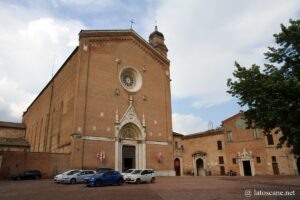
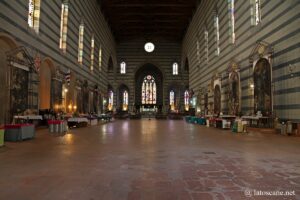
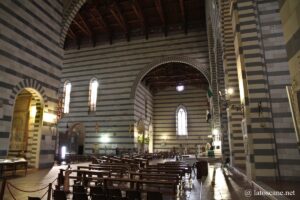
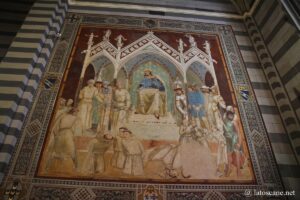
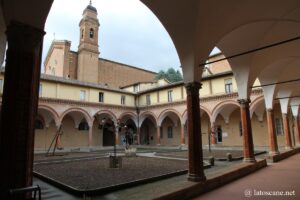
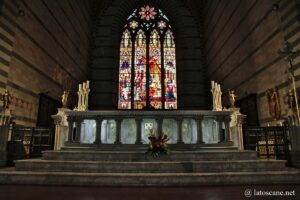
Its plan is T-shaped, the cross of Saint Francis, with a single and immense nave covered with a visible frame, chapels oriented towards the transept. The interior walls are made of white and black marble slabs.
The splendid crypt of the basilica is currently used as the faculty library.
On the other side of the façade, there are still some 15th century frescoes, a Nativity of Jesus from Sodom and the old portal on the left side of the 15th century.
On the left side of the nave there are several works, including 17th century paintings.
On the right side of the nave there are three canvases from the 16th and 17th centuries, frescoes, and the main chapel was designed by Giuseppe Partini and is dominated by a beautiful 19th century stained glass window.
The central chapel is framed by eight chapels. The first one has a fresco from the cloister of the convent painted by Jacopo di Mino del Pellicciaio; the second one has two wonderful frescoes by Ambrogio Lorenzetti; the fourth one has a fresco by Pietro Lorenzetti with the Martyrdom of the Franciscan Friars; the fifth has a Madonna with Child by Andrea Vanni; the sixth the marble funerary monument of Cristoforo Felici, made in 1463 by Urbano da Cortona; and in the seventh a bas-relief by Giovanni D’Agostino.
In the central chapel, the high altar is by Leopoldo Maccari and Giuseppe Partini with the funerary effigies of Silvio Piccolomini and Vittoria Forteguerri, parents of Pope Pius II.
On the right side of the basilica, the former convent is now home to some faculties of the University of Siena and the diocesan museum of sacred art.
On the square, the Oratory of the Company of Saint Bernardine was built in 1400 where Bernardine came to preach.
San Clemente in Santa Maria dei Servi church
San Clemente in Santa Maria dei Servi is a Gothic church of Siena built from 1255, consecrated only in 1533, with an unfinished 15th century stone and brick facade.
It was built on the Valdimontone hill, on the site of an ancient Roman temple dedicated to the god Mithras, by the Servites from the convent of Mount Senario.
The exterior is clean as usual in mendicant orders.
There are different styles: the transept and the terminal chapels of gothic style, the three naves of renaissance style and vaults crossed and corinthian capitals, the Romanesque bell tower erected between the 14th and 15th centuries.
Inside are especially works dedicated to the Virgin Mary, including the Madonna del Bordone, a work by Coppo di Marcovaldo when he was a captive of the Sienese after the battle of Montaperti in 1260, in exchange for her release; the Coronation of the Virgin by Bernardino Fungai, the Virgin of Mercy by John Paul, the Nativity of Mary by Rutilio Manetti in 1625; the Massacre of the Innocents and a Madonna and Child, by Matteo di Giovanni from 1491. Jacopo di Mino del Pellicciaio painted in 1364 the Madonna di Belvedere etc.
During the 19th and 20th centuries, many artists participated in the decoration of chapels.
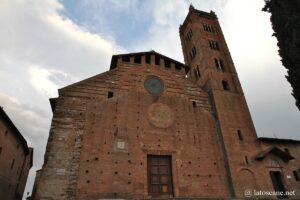
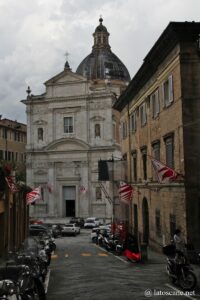
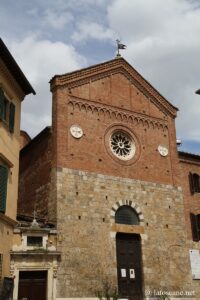
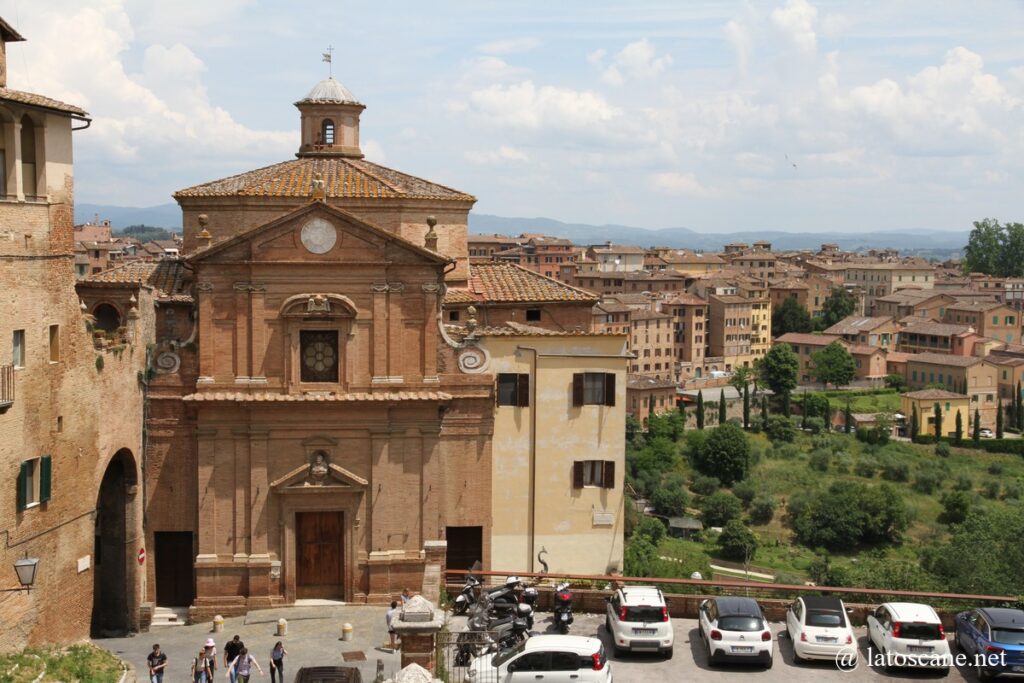
Santa Maria di Provenzano church in Siena
The Collegiate Church of Provenzano dates from 1595 to 1604, with a single nave surmounted by an octagonal cupola above the chancel.
It has a beautiful marble facade divided into two floors, topped by a central tympanum flanked by two small volutes.
The interior contains many works of art, including the late 15th century terracotta bust on the master altar known as Madonna di Provenzano, a virgin considered miraculous. The bust would have resisted the blows of a sword of a Spanish soldier during the occupation by Charles V in the middle of the 16th, which damaged the arms and the figure.
San Donato church in Siena
San Donato (Saint Donatus in English) is a baroque church. A first church dedicated to the Archangel Saint Michael dates back at least to the 12th century. Late seventeenth century, the Carmelites rebuilt it in a baroque style.
The current façade is a restoration of neo-medieval style from 1940-1942, with a lower part in stone, upper in bricks, a rose window in marble. In the crossing are remains of the Romanesque church.
San Giuseppe church in Siena
The church of San Giuseppe was built from 1522 on the initiative of a lumberjack guild, with an octagonal dome topped by a lantern. The façade, mainly made of bricks, was completed in 1653.
Above the portal is a bust of Saint Joseph by Tommaso Redi, sculpted in 1653.
The interior has a rich historical and artistic heritage dating from the seventeenth, eighteenth and nineteenth centuries. The cupola is decorated with a fresco attributed to Apollonio Nasini with the Genealogy of Saint Joseph from 1735.
The baroque stucco altar dates from 1685 with a statue in the centre of Saint Joseph.
San Pietro alla Magione church
San Pietro alla Magione dates back to at least the 10th century. In the 12th century, the Templars built a hospice in a house (a “magione”). In 1312, the church passed to the Order of Knights of the Hospital.
It is built of stone, with a portal and a Romanesque steeple. Its austere Romanesque interior was restored in 1957. The gothic tabernacle dates from the second half of the 14th century. There are fragments of frescoes with a Crucifixion and biblical episodes. The chapel on the right was built in the 16th century at the end of the plague.
Santa Maria in Portico a Fontegiusta church
Santa Maria in Portico a Fontegiusta is a Renaissance church, built in 1482-84 to celebrate the victory of Siena over the Florentines at the battle of Poggio Imperiale at Poggibonsi on 7 September 1479.
On the left wall is a fresco of Sibylle Announcing the Birth of Christ to Emperor Augustus, attributed to Baldassarre Peruzzi, but perhaps by Daniele da Volterra.
The marble altar is from the 16th century. Side frescoes from the late 16th century depict episodes of the life of the virgin.
The old Pescaja Gate (or Porta Fontegiusta) was located at the apse, and was walled off to protect the city.
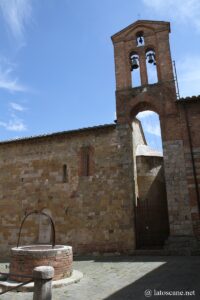
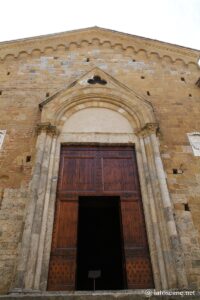
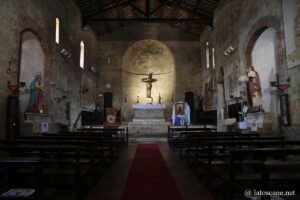
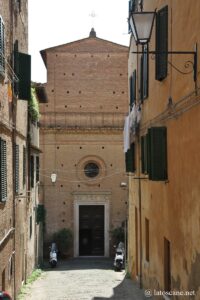
Map with others churches of Siena
If you see this after your page is loaded completely, leafletJS files are missing.
Sources and links
- Tourist portals : visitsienaofficial.it, www.terredisiena.it
- Informations : en.wikipedia.org
Articles about Siena
- Siena
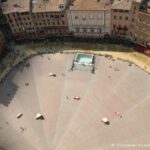 Siena is with Florence one of the most attractive destinations in the region. City of the famous palio, an equestrian race, it is a unique medieval town located in the ...
Siena is with Florence one of the most attractive destinations in the region. City of the famous palio, an equestrian race, it is a unique medieval town located in the ... - Things to do and see in Siena
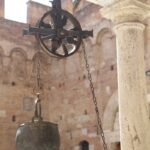 Siena deserves plenty of days to measure its charm. However, it is not a very large city and two days can be enough to bring back beautiful memories. Piazza del Campo ...
Siena deserves plenty of days to measure its charm. However, it is not a very large city and two days can be enough to bring back beautiful memories. Piazza del Campo ... - Piazza del Campo in Siena
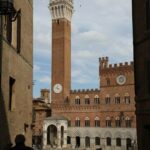 The Piazza del Campo is undoubtedly one of the most beautiful and elegant squares in the world, built between 1293 and 1349. It is the heart of the city of ...
The Piazza del Campo is undoubtedly one of the most beautiful and elegant squares in the world, built between 1293 and 1349. It is the heart of the city of ... - Siena Cathedral
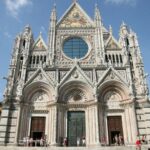 The Siena Cathedral dedicated to Assumption of Mary (Cattedrale di Santa Maria Assunta in Italian) stands out for its white and black stones and marble is certainly one of the ...
The Siena Cathedral dedicated to Assumption of Mary (Cattedrale di Santa Maria Assunta in Italian) stands out for its white and black stones and marble is certainly one of the ... - Palazzo Pubblico in Siena
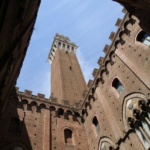 The most imposing building in Piazza del Campo is the Palazzo Pubblico with the very large tower next to the Torre della Mangia. Also called Communal Palace, it was built ...
The most imposing building in Piazza del Campo is the Palazzo Pubblico with the very large tower next to the Torre della Mangia. Also called Communal Palace, it was built ... - Civic Museum of Siena
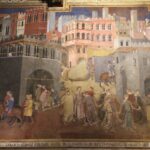 The Siena Civic Museum, the Museo Civico, was built in the 1930s on the first and second floors of the Palazzo Pubblico. Its visit (about an hour) is highly recommended, ...
The Siena Civic Museum, the Museo Civico, was built in the 1930s on the first and second floors of the Palazzo Pubblico. Its visit (about an hour) is highly recommended, ... - Palio di Siena
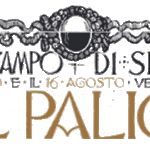 The Palio of Siena is a famous equestrian race that pits the different districts of the city (called the contrade), whose origins date back to the medieval games, held on ...
The Palio of Siena is a famous equestrian race that pits the different districts of the city (called the contrade), whose origins date back to the medieval games, held on ... - Santa Maria della Scala Hospital
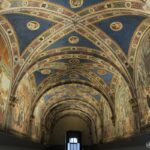 The ancient hospital for pilgrims, Santa Maria della Scala, is home to a vast and rich museum complex in Siena that covers 19,000 m 2. It is an essential step ...
The ancient hospital for pilgrims, Santa Maria della Scala, is home to a vast and rich museum complex in Siena that covers 19,000 m 2. It is an essential step ... - Fountains and bottini of Siena
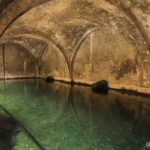 In Siena there are some fountains, fed by the bottini, the galleries of a medieval underground aqueduct built from the 12th century. These galleries are 25 km in length, channelling ...
In Siena there are some fountains, fed by the bottini, the galleries of a medieval underground aqueduct built from the 12th century. These galleries are 25 km in length, channelling ... - Palaces in Siena
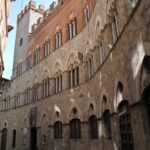 The streets of Siena are charming with their splendid palaces, most of them from the Middle Ages, some dating back to the Renaissance. They do not lack elegance with their ...
The streets of Siena are charming with their splendid palaces, most of them from the Middle Ages, some dating back to the Renaissance. They do not lack elegance with their ... - Pinacoteca Nazionale in Siena
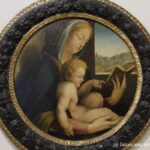 The Pinacoteca Nazionale di Siena is an important Italian museum, especially for its collection of ” paintings on gold background ” from the 14th and 15th centuries in Siena. It ...
The Pinacoteca Nazionale di Siena is an important Italian museum, especially for its collection of ” paintings on gold background ” from the 14th and 15th centuries in Siena. It ... - Basilica of San Dominico in Siena
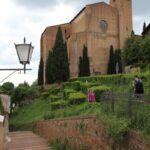 The Basilica di San Domenico in Siena, also known as Basilica Cateriniana, is one of the most important churches in the city, with its imposing Gothic architecture and Renaissance works. ...
The Basilica di San Domenico in Siena, also known as Basilica Cateriniana, is one of the most important churches in the city, with its imposing Gothic architecture and Renaissance works. ... - Saint Catherine Sanctuary in Siena
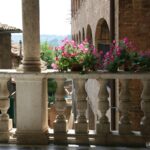 The Sanctuary of Saint Catherine of Siena (Santuario-Casa di Santa Caterina) is located on Hill San Antonio in Siena, consisting of the old house of the Benincasa, the family of ...
The Sanctuary of Saint Catherine of Siena (Santuario-Casa di Santa Caterina) is located on Hill San Antonio in Siena, consisting of the old house of the Benincasa, the family of ... - Gates and other sights of Siena
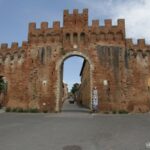 This page is dedicated to other interesting places in Siena, including its walls and gates, loggias, the Medici Fortress, some squares and streets of the center. Walls and gates of Siena Siena ...
This page is dedicated to other interesting places in Siena, including its walls and gates, loggias, the Medici Fortress, some squares and streets of the center. Walls and gates of Siena Siena ... - Tickets and guided tours in Siena
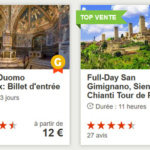 Tickets and proposals for guided tours in Siena, entrance tickets, city tours, with the cathedral complex, Piazza del Campo, excursions in the surrounding area, activities, etc Into the same category
Tickets and proposals for guided tours in Siena, entrance tickets, city tours, with the cathedral complex, Piazza del Campo, excursions in the surrounding area, activities, etc Into the same category - Interactive map of Siena
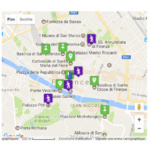 Carte de Sienne interactive avec les principaux monuments et les lieux secondaires, églises, palais et musées
Carte de Sienne interactive avec les principaux monuments et les lieux secondaires, églises, palais et musées - Hotels and accommodations in Siena
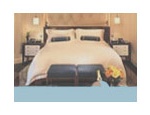 Book now accommodation in Siena, between hotel, rooms and apartments. Hundreds of choices with customer ratings
Book now accommodation in Siena, between hotel, rooms and apartments. Hundreds of choices with customer ratings - Short history of Siena
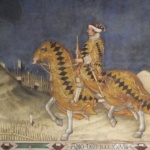 Although it seems that the Etruscans had occupied the territory of Siena, its foundation dates from the time of the emperor Augustus where a Roman colony was established under ...
Although it seems that the Etruscans had occupied the territory of Siena, its foundation dates from the time of the emperor Augustus where a Roman colony was established under ...
No Comments Yet